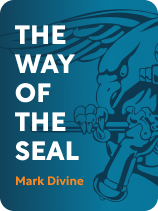

This article is an excerpt from the Shortform book guide to "The Way of the SEAL" by Mark Divine. Shortform has the world's best summaries and analyses of books you should be reading.
Like this article? Sign up for a free trial here.
Why do leaders need to have grit? How can you be mentally tough in the workplace?
Grit is a combination of perseverance and passion, meaning that people with grit are resilient to setbacks in order to succeed. It also means being mentally tough because they don’t let anything get in their way.
Let’s look at how to be mentally tough, according to The Way of the SEAL by Mark Divine.
Bolster Your Mental Fortitude
Divine says strong leaders know how to be mentally tougher than everyone else and refuse to give up during life’s most challenging moments. In other words, they have “grit.” This mental toughness comes from honing their ability to:
- Manage their physical and emotional response
- Turn negative self-talk that hampers performance into positives and tap the power of their subconscious
- Visualize their success
Together, these skills can help you tap your inner power and function at your best. (Shortform note: There’s a long history of people training their minds to overcome adversity. In The Obstacle Is the Way, Ryan Holiday explains that the Stoics considered themselves mental athletes. They trained their mental muscles to build “Inner Citadels” impervious to hardship. Other historical figures took this a step further, using disadvantages they were born with to motivate them. For example, Theodore Roosevelt struggled with debilitating asthma as a child but worked out daily and eventually overcame it. He said this training prepared him to endure more difficult moments, like his wife’s death, election losses, and assassination attempts.)
1. Manage Your Physical and Emotional Response
To bolster your mental fortitude, you must first control your body’s primitive, physiological response to stress, which launches you into fight, flight or freeze mode. This process sends cortisol and adrenaline rushing through your body to protect you from danger. When it happens, you can’t process information clearly. To manage your physiological stress, bring your body back into alignment, and refocus: Engage in deep breathing exercises we discussed in Action 2 of this guide.
(Shortform note: Psychologists say the amygdala is responsible for sending you into fight-or-flight mode. To exit that mode, you must tap the prefrontal cortex—your brain’s CEO—by slowing down, focusing on what you can control, and breathing, as Divine advises. The prefrontal cortex tells the amygdala to turn off fight-or-flight, takes over, and helps you respond calmly and deliberately.)
If regular deep breathing isn’t enough to address your stress, ground yourself with the yogic, box breathing technique that Navy SEALs use: Find a quiet space to sit where you won’t be disturbed. Taking four slow, deep breaths in and out. Then, start box breathing: Inhale through your nose for four counts, hold your breath for four counts, exhale for four counts, hold your breath for four counts. Repeat the cycle. Do this for at least five minutes, and let random thoughts that arise as you breathe to come and go without judgment.
(Shortform note: Another way to respond to your physiological stress is to bypass your amygdala and go straight to your prefrontal cortex. To do this, regularly practice mindfulness so you don’t allow automatic, worrying thoughts to consume you. First, imagine you’re an impartial observer charged with paying attention to, and not judging, your unhelpful thoughts and emotions. Then if a fear arises, say to yourself: “I notice that fear is here, making my heart pound. I notice that this makes me want to curl up into a ball. Would that be helpful to do right now?” Research shows that when people practice mindfulness, their prefrontal cortex and amygdala communicate more strongly during times of stress.)
2. Turn Negatives Into Positives
Once you’ve realigned your body and mind, address self-critical talk to enhance your mental fortitude. When you repeatedly respond positively to negative self-talk, you create a virtuous cycle that helps you bounce back more quickly from setbacks so you can achieve your goals. This practice promotes your sense of self-worth and confidence in your abilities, which builds your resilience and mental fortitude.
Divine learned firsthand that when you don’t keep your emotions in check they can get the better of you. While training in hand-to-hand combat, a fellow SEAL accidentally knocked out his front tooth. Enraged, Divine lashed out then spent hours in a foul mood. He later realized that his anger had decreased his focus, led his muscles to tighten up, and worsened his performance. Once aware of this, he replaced his negative feelings with determination, which made him more confident and effective in future training.
To avoid perpetuating a cycle of negativity, recognize that your feelings and thoughts aren’t you but, rather, things you experience that come and go. This creates a space between you and your emotions so you can see them as a part of you that sometimes comes to visit then leaves—and not all-defining characteristics that are you or control you.
To transform negative self-talk and emotions into positives, pay attention and respond to negative self-commentary with positive, action-oriented language. For example, if you think: “I failed that test, I’m so stupid!” counter this with: “I’m smart. I’ll keep learning and working hard and ace the next test!”
3. Tap the Power of Your Subconscious
Another way to bolster your mental toughness is to heighten your awareness of your surroundings. When you take in information that’s not readily apparent at a surface level, you can sense and avoid danger and navigate unpredictable, chaotic situations. Divine says you have two levels of awareness:
1. Casual awareness: You visually take in the big picture of a situation and quietly observe and let information flow into you. This lets information pass in and out of your subconscious mind, communicating it to you when you need it most.
2. Heightened awareness: You visually focus intensely on a situation or thing and process information from a fully engaged state. This allows you to shut out distractions and focus on achieving your goals.
Divine says you should shift fluidly between these two levels to focus, take decisive action, block out distractions, and absorb information you need to effectively navigate tough situations.
4. Visualize Your Success
To bolster your mental strength is to mentally walk through best- and worst-case scenarios you could encounter as you strive to achieve your goals. When you visualize yourself achieving your goals and prepare for obstacles, you have greater confidence in your ability to confront the worst and succeed.
Divine discovered the value of this tactic in his early twenties, when he quit his job to enter Officer Candidate School (OCS), then discovered he’d have to wait nine months to find out if he’d been accepted. Discouraged, he started regularly visualizing himself as the man he hoped to become once he’d completed the program: running, shooting, rappelling, having conversations with other SEALs, and succeeding at the highest levels. The experience felt more real and integrated each time he practiced—to the point that he deeply believed that being a SEAL was his destiny. Nine months later, he was one of two OCS candidates with a SEAL contract admitted that year.
Divine recommends several visualization strategies to build confidence in your ability to get in a positive state of mind, execute in the moment, and enhance your mental strength. Two are guided meditation and mentally rehearsing actions you’ll take to achieve your goals.
1. In guided meditation you walk through a series of images to allow your mind to relax, heal, or tap into your subconscious. This helps you think clearly, eliminate distractions, and focus on your goals.
2. In mental rehearsal you mentally walk through every step you’ll take to achieve your goal, including how you’ll respond to obstacles you could face. This prepares you for worst-case scenarios and to manage fears, so when you go through the motions in real life you’re not caught off guard and can adapt.

———End of Preview———
Like what you just read? Read the rest of the world's best book summary and analysis of Mark Divine's "The Way of the SEAL" at Shortform.
Here's what you'll find in our full The Way of the SEAL summary:
- A former Navy SEAL's strategies to help business leaders
- A mind-body technique that combines yoga, martial arts, and SEAL training
- How to bolster and harness your mental fortitude






